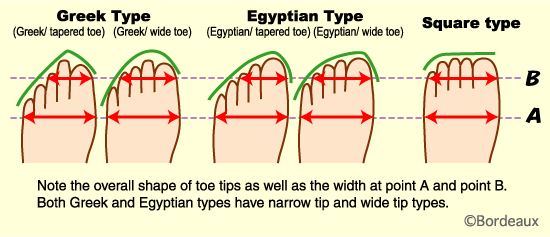|
-
16th March 08, 05:41 AM
#101
Five generations without an immigrant and my toes are even. Man, I'm puttin' on the kilt and going out for a Guiness.
-
-
16th March 08, 10:43 AM
#102
What is referred here as "Celtic toe" is normally called Morton's toe.
http://en.wikipedia.org/wiki/Morton's_toe
..Although commonly described as a disorder, it is sufficiently common to be considered a normal variant of foot shape (its prevalence varies with different populations, but around 10% of feet worldwide have this form). In shoe-wearing cultures it can be problematic: for instance, in causing nail problems from wearing shoes with a profile that doesn't accommodate the longer second toe.
It has a long association with disputed anthropological and ethnic interpretations. Morton called it Metatarsus atavicus, considering it an atavism recalling prehuman grasping toes. In statuary and shoe fitting it has been called the Greek foot (as opposed to the Egyptian foot, where the great toe is longer). It was an idealised form in Greek sculpture, and this persisted as an aesthetic standard through Roman and Renaissance periods and later (the Statue of Liberty has toes of this proportion). The French call it pied ancestral or pied de Néanderthal, believing it to be a sign of intelligence. Podiatrist/archaeologist Phyllis Jackson has interpreted it as a characteristically Celtic toe, as opposed to a Saxon toe. Cleopatra was known to have this, and many consider this trait to be a sign of beauty.
I will also add that many Egyptian idols such as the lion-headed Sekhmet had Morton's toe so despite the widespread depiction of the Egyptian form in sculpture by the Egyptians it did too find their way into some sculpture as, obviously, some idealization of beauty.

Despite redish light coloured hair and fair skin, Morton's toe and very long and narrow a foot I would very strongly doubt that I have Celtic forebears.
(P.S.: In Germany as the UK the most common widths today are wide. The "Greek foot form" is a tiny minority.)
-
-
16th March 08, 12:18 PM
#103
 Originally Posted by Frank McGrath

Five generations without an immigrant and my toes are even. Man, I'm puttin' on the kilt and going out for a Guiness.
I'll join ye, laddy!!
"Two things are infinite- the universe, and human stupidity; and I'm not sure about the universe." Albert Einstein.
-
-
16th March 08, 09:36 PM
#104
 Originally Posted by Nanook

... In statuary and shoe fitting it has been called the Greek foot (as opposed to the Egyptian foot, where the great toe is longer). It was an idealised form in Greek sculpture, and this persisted as an aesthetic standard through Roman and Renaissance periods and later (the Statue of Liberty has toes of this proportion). The French call it pied ancestral or pied de Néanderthal, believing it to be a sign of intelligence. Podiatrist/archaeologist Phyllis Jackson has interpreted it as a characteristically Celtic toe, as opposed to a Saxon toe. Cleopatra was known to have this, and many consider this trait to be a sign of beauty...
So, do we have in this proof that Celts are descended from the Greeks? or from the Neanderthals?
-
-
17th March 08, 02:18 AM
#105
 Originally Posted by Nighthawk

I'll join ye, laddy!!
Be right there !
Robert Amyot-MacKinnon
-
-
17th March 08, 05:34 AM
#106
 Originally Posted by gilmore

So, do we have in this proof that Celts are descended from the Greeks? or from the Neanderthals?
Actually,humans are not descended from neanderthals.
I kinda doubt if you have the "Celtic toe" it means you're Celtic, highly doubt it.
-
-
17th March 08, 07:43 AM
#107
Actually, that is not so certain. After all, Neanderthals WERE humans as well as us, homo sapiens. To the best of my knowledge, there continues to be debate as to whether the two species(?) were able to reproduce together.
Incidentally, I seem to have the "celtic" foot, but got it from a different line that my Galician grandmother. What does that mean? 
-
-
17th March 08, 08:32 AM
#108
I do not have a "celtic foot" but then, I am from Norman stock.
-
-
17th March 08, 08:58 AM
#109
I think that this smacks of eugenics, rather than the scientific method of genetics. The Nazi party was fond of that sudo-science, and look where it took them.
Frank
-
-
17th March 08, 11:58 AM
#110
I would disagree strongly with that, HIghland. People here have simply been discussing family traits. It's just like when I met a cousin for the first time from a branch of the family which had lost touch. I was wearing sandals, and she looked at me in surprise and said, "You have Daddy's feet! 
Additionally, I am pretty sure that my father's remaining family in Europe was wiped out by the Nazis, so I would be reacting just as strongly if I felt the same as you.
-
Similar Threads
-
By CameronTaylor in forum General Celtic Music Talk
Replies: 8
Last Post: 16th March 08, 07:30 AM
-
By Nerts in forum General Kilt Talk
Replies: 1
Last Post: 31st July 07, 10:19 AM
-
By davedove in forum Highland Games and Celtic Event Discussion
Replies: 5
Last Post: 29th June 06, 05:51 AM
-
By Sherry in forum Miscellaneous Forum
Replies: 1
Last Post: 8th February 06, 03:44 PM
-
By F16WarBird in forum Highland Games and Celtic Event Discussion
Replies: 18
Last Post: 28th June 05, 03:53 AM
 Posting Permissions
Posting Permissions
- You may not post new threads
- You may not post replies
- You may not post attachments
- You may not edit your posts
-
Forum Rules
|
|
Bookmarks